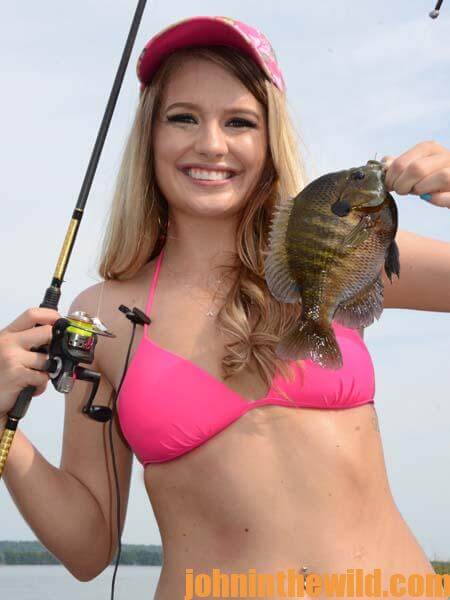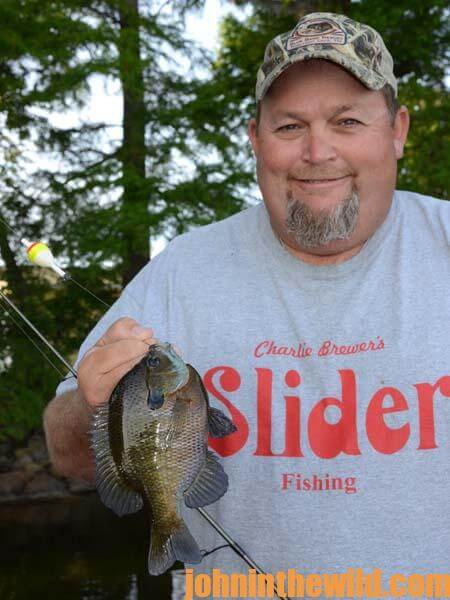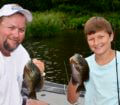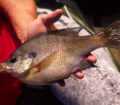John’s Note: Billy Blakely is the chief guide for Blue Bank Resort (http://www.bluebankresort.com – 877-258-3226) on Reelfoot Lake in northwest Tennessee. From May through October, Reelfoot is one of the premier bluegill fishing lakes in the nation. Because he’s been fishing and guiding all his life, Blakely has assumed through the years that he knows where every bluegill bed on the lake is located until recently when technology drastically has changed his ability to find and take bluegills.
 I believe the side-scanning depth finder has re-written the book on where bluegills bed, and what causes them to move off the bed or quit biting. When I first learned what a bluegill bed looked like on a side-scan depth finder, I was determined to find as many bluegill beds as possible. When I’ve been bluegill fishing, I’ve never even considered the idea of fishing for bluegills in the fronts of boat ramps. Reason dictates with boats going into the water, engines cranking up, boats idling and then the motors running relatively hard to push boats up on trailers, obviously bluegills won’t bed where there’s that much commotion. But that side-scan depth finder has been teaching me what I don’t know about bluegills, as in where they bed. Just about every boat ramp I’ve checked with my side-scanning depth finder will have a bluegill bed out in the water in front of it. I don’t know why putting the boat in, taking it off the trailer and later pushing it back on the trailer doesn’t scare a bluegill off the bed, but apparently it doesn’t. After I’ve thought about the idea, I’ve realized that when an angler is putting his engine into reverse to back it off the trailer and later throttles down to push the boat onto the trailer, that prop wash is cleaning the debris off the bottom. So, the bottom at a boat ramp may be one of the hardest bottoms and debris-free bottoms in the lake. Then you have to factor in the notion that no one in his right mind fishes for bluegills in front of a boat ramp, which means the boat-ramp bluegill beds never get fished. So, the bluegills on those beds have a chance to grow older and bigger.
I believe the side-scanning depth finder has re-written the book on where bluegills bed, and what causes them to move off the bed or quit biting. When I first learned what a bluegill bed looked like on a side-scan depth finder, I was determined to find as many bluegill beds as possible. When I’ve been bluegill fishing, I’ve never even considered the idea of fishing for bluegills in the fronts of boat ramps. Reason dictates with boats going into the water, engines cranking up, boats idling and then the motors running relatively hard to push boats up on trailers, obviously bluegills won’t bed where there’s that much commotion. But that side-scan depth finder has been teaching me what I don’t know about bluegills, as in where they bed. Just about every boat ramp I’ve checked with my side-scanning depth finder will have a bluegill bed out in the water in front of it. I don’t know why putting the boat in, taking it off the trailer and later pushing it back on the trailer doesn’t scare a bluegill off the bed, but apparently it doesn’t. After I’ve thought about the idea, I’ve realized that when an angler is putting his engine into reverse to back it off the trailer and later throttles down to push the boat onto the trailer, that prop wash is cleaning the debris off the bottom. So, the bottom at a boat ramp may be one of the hardest bottoms and debris-free bottoms in the lake. Then you have to factor in the notion that no one in his right mind fishes for bluegills in front of a boat ramp, which means the boat-ramp bluegill beds never get fished. So, the bluegills on those beds have a chance to grow older and bigger.
 My son Jack and I won a bluegill tournament in 2014 fishing right in front of a boat ramp. We saw bubbles coming up from the bottom, indicating there were bluegills there. We’d already run across that bed with our boat and didn’t think there was any way in the world that we could catch bluegills from that bed after that. However, when we looked at that bed with my side-scan depth finder, we could see the bluegills were still on the bed. We started fishing and filled-up our cooler with some of the biggest bluegills we’d ever caught. I’ll have to admit; when I first started seeing bluegill beds in front of boat ramps, I really didn’t believe the depth finder. Although the boat-ramp bluegill beds looked just like the bluegill beds I’d found in open water, not until I began to fish those boat-ramp bluegill beds did I become a believer.
My son Jack and I won a bluegill tournament in 2014 fishing right in front of a boat ramp. We saw bubbles coming up from the bottom, indicating there were bluegills there. We’d already run across that bed with our boat and didn’t think there was any way in the world that we could catch bluegills from that bed after that. However, when we looked at that bed with my side-scan depth finder, we could see the bluegills were still on the bed. We started fishing and filled-up our cooler with some of the biggest bluegills we’d ever caught. I’ll have to admit; when I first started seeing bluegill beds in front of boat ramps, I really didn’t believe the depth finder. Although the boat-ramp bluegill beds looked just like the bluegill beds I’d found in open water, not until I began to fish those boat-ramp bluegill beds did I become a believer.
Another thing I’ve learned about bluegill fishing is that anglers can build bluegill beds, just like crappie fishermen put out brush to attract both crappie and bass. I started noticing round circles on the bottom of Reelfoot Lake and figured out those circles were automobile tires a little off the bottom, filled inside with pea gravel. The bluegills were bedding in the centers of those tires on the pea gravel. I also noticed that there were spots out in front of some piers that seemed to have harder bottoms than I found around other piers. Through some investigation, I learned that some lake owners poured several bags of pea gravel out in front of their piers to create a hard bottom for bluegills and bass to spawn.
 Although most of my life I’ve fished bluegill beds on natural bottom and on top of stumps, I’ve also seen how effective pouring out pea gravel on the bottom can be to attract and create bedding sites for bluegill. Basically I’m an old-time bluegill fisherman and bluegill guide, but what I’ve learned from using a side-scanning depth finder is that I can find undiscovered bluegill beds out in deep water, and well away from the bank on almost any lake I fish. I also can locate catfish bedding next to underwater stumps and logs and see where crappie are holding on bottom breaks, brush tops, brush pilings and other. I believe that side-scanning depth finders have brought to the freshwater fishermen all the advantages in sonar that saltwater fishermen have had for years. By learning how to use the advantages of the side-scan, I can find and catch more and bigger bluegills than ever I did in the past.
Although most of my life I’ve fished bluegill beds on natural bottom and on top of stumps, I’ve also seen how effective pouring out pea gravel on the bottom can be to attract and create bedding sites for bluegill. Basically I’m an old-time bluegill fisherman and bluegill guide, but what I’ve learned from using a side-scanning depth finder is that I can find undiscovered bluegill beds out in deep water, and well away from the bank on almost any lake I fish. I also can locate catfish bedding next to underwater stumps and logs and see where crappie are holding on bottom breaks, brush tops, brush pilings and other. I believe that side-scanning depth finders have brought to the freshwater fishermen all the advantages in sonar that saltwater fishermen have had for years. By learning how to use the advantages of the side-scan, I can find and catch more and bigger bluegills than ever I did in the past.
To learn more about bluegill fishing, go to www.amazon.com/kindle/author/johnephillips, and click on his Kindle eBook and print book, “Reelfoot Lake: How to Fish for Crappie, Bass, Bluegills and Catfish & Hunt for Ducks.”










